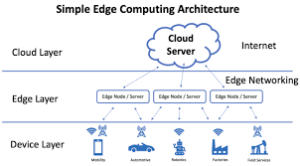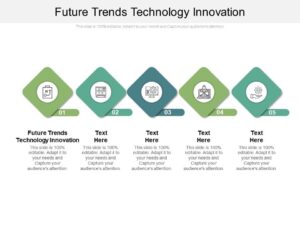Introduction:
In the realm of technology, One such innovation that is rapidly gaining traction and reshaping the landscape of data processing is edge computing.

Unlike traditional centralized cloud computing, edge computing brings computation and data storage closer to the sources of data generation, enabling faster processing and real-time insights. In this blog, we’ll delve into the burgeoning phenomenon of edge computing,
Understanding Edge Computing:
At its core, edge computing involves decentralizing computing resources and moving them closer to the edge of the network, where data is generated. This approach minimizes latency by processing data locally, enabling faster response times and reducing the strain on network bandwidth.
What is Edge Computing: At its core, edge computing involves moving data processing closer to the source of data generation, i.e., the “edge” of the network. often located near the data source. This proximity minimizes the latency inherent in transmitting data to distant data centers, thereby enabling faster response times and enhanced performance.

Key Components and Architecture:
The architecture of edge computing comprises three main components: edge devices, edge servers, and edge networks.
Edge Devices: These are the endpoints where data is generated, such as IoT sensors, mobile devices, and industrial machinery. Edge devices collect raw data from the physical world and often preprocess it before transmitting it to the edge server for further analysis.
Edge Servers: Positioned closer to the edge devices, edge servers serve as intermediate hubs for processing and analyzing data. They perform tasks such as data aggregation, filtering, and basic analytics, thus reducing the volume of data that needs to be transmitted to the central cloud infrastructure.
Applications and Use Cases:
Edge computing finds applications across various industries, transforming processes and enabling innovative solutions:
IoT: Edge computing enhances IoT applications by enabling real-time data analysis and decision-making at the edge, improving efficiency and responsiveness.
Smart Cities: In smart city deployments, edge computing enables applications such as traffic management, public safety monitoring, and environmental sensing, enhancing urban efficiency and sustainability.
Telecommunications: Edge computing is crucial for telecom operators, enabling them to deliver low-latency services like augmented reality, virtual reality, and online gaming, while also optimizing network resources.
Retail: In retail environments, edge computing facilitates personalized customer experiences, inventory management, and real-time analytics, enhancing operational efficiency and customer satisfaction.
Benefits and Challenges:
The adoption of edge computing offers several benefits:
Reduced Latency: By processing data closer to the source, edge computing minimizes latency, enabling real-time responses and improved user experiences.

Improved Reliability: Edge computing enhances reliability by reducing dependency on centralized infrastructure, making systems less susceptible to network failures or disruptions.
Bandwidth Optimization: Edge computing reduces the volume of data transmitted to centralized data centers, optimizing bandwidth usage and reducing network congestion.
However, the implementation of edge computing also presents challenges:
Security Concerns: Distributing processing power across a network increases the attack surface, making edge devices vulnerable to security threats and breaches.
Interoperability Issues: Ensuring compatibility and seamless integration between diverse edge devices and platforms can be challenging, requiring standardized protocols and frameworks.
Resource Constraints: Edge devices often have limited computational resources and storage capacity, posing constraints on the complexity and scale of applications that can be deployed at the edge.
Future Trends and Innovations:
As edge computing continues to evolve, several emerging trends and innovations are shaping its trajectory, offering new opportunities and capabilities for businesses and industries. Here are some key future trends to watch:

AI and Machine Learning at the Edge:
The integration of artificial intelligence (AI) and machine learning (ML) capabilities at the edge is poised to revolutionize data processing and analytics. By deploying AI models directly onto edge devices.
Edge-native Applications:
The development of edge-native applications optimized for distributed edge environments is gaining momentum. These applications are designed to leverage the unique characteristics of edge computing.
Fog Computing and Hybrid Edge-Cloud Architectures:
Fog computing, an extension of edge computing that extends the edge paradigm to include intermediary fog nodes, is gaining traction as a complementary approach to traditional cloud computing.
5G and Edge Convergence:
The rollout of 5G networks is driving convergence between edge computing and telecommunications, unlocking new possibilities for ultra-low-latency, high-bandwidth edge applications
Edge-to-Cloud Orchestration and Management:
As edge environments become more complex and heterogeneous, the need for robust orchestration and management solutions becomes critical. Edge-to-cloud orchestration platforms enable organizations to seamlessly deploy.
Impact on Society and Industry:
Edge computing is revolutionizing the way society interacts with technology and how industries operate. Its impact spans various facets of society and industry, bringing about transformative changes that enhance efficiency, drive innovation, and improve the overall quality of life. Here’s a closer look at the significant impact of edge computing:

Improved Efficiency and Responsiveness:
By processing data closer to the source, edge computing reduces latency and enables real-time decision-making. This improved efficiency enhances the responsiveness of applications and services across industries,
Empowering IoT and Smart Cities:
Edge computing is instrumental in powering the Internet of Things (IoT) and enabling the development of smart cities.
Healthcare Transformation:
In the healthcare sector, edge computing enables remote patient monitoring, personalized medicine, and real-time diagnostics. By processing sensitive patient data locally.
Enhanced Industrial Automation:
Edge computing revolutionizes industrial automation by enabling predictive maintenance, real-time monitoring, and optimization of manufacturing processes. By analyzing data at the edge.
Supporting Environmental Sustainability:
Edge computing plays a role in supporting environmental sustainability efforts by enabling real-time monitoring and optimization of energy usage and resource management.
Best Practices and Considerations:
Deploying edge computing solutions requires careful planning, implementation, and management to ensure optimal performance, security, and scalability.

Define Clear Objectives and Use Cases:
Before deploying edge computing infrastructure, clearly define the objectives and use cases to ensure alignment with business goals. Identify specific scenarios where edge computing can provide tangible benefits, such as reducing latency, improving reliability, or enabling real-time analytics.
Select Appropriate Edge Devices and Hardware:
Choose edge devices and hardware that are well-suited to the requirements of your applications and environments. Consider factors such as processing power, memory, storage, and connectivity options to ensure compatibility and optimal performance.
Implement Robust Security Measures:
Security is paramount in edge computing deployments, given the distributed nature of edge infrastructure and the potential exposure to security threats. Implement robust security measures.
Optimize Data Processing and Storage:
Optimize data processing and storage at the edge to minimize latency and bandwidth usage. Use edge analytics and data filtering techniques to preprocess data locally and transmit only relevant information to centralized servers.
Implement Redundancy and Failover Mechanisms:
Build redundancy and failover mechanisms into edge computing deployments to ensure high availability and resilience. Implement redundant edge nodes, load balancing, and failover mechanisms to mitigate the impact of hardware failures, network outages, or other disruptions.
Continuously Evaluate and Iterate:
Continuously evaluate the performance, effectiveness, and alignment of edge computing deployments with business goals and evolving requirements. Collect feedback from users, monitor key performance indicators (KPIs), and conduct periodic reviews to identify areas for improvement and optimization.
Conclusion:
In conclusion, the rise of edge computing marks a paradigm shift in the way we process and analyze data. By bringing computation closer to the source of data generation, edge computing promises to revolutionize industries, drive innovation, and transform the future of technology. As we embark on this journey towards a decentralized computing paradigm, the possibilities are endless, and the opportunities boundless. The era of edge computing has arrived, and its impact will be felt far and wide, shaping the digital landscape for generations to come.

